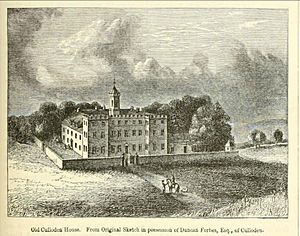Siege of Culloden House (1745) facts for kids
Quick facts for kids Siege of Culloden House |
|||||||
|---|---|---|---|---|---|---|---|
| Part of the Jacobite rising of 1745 | |||||||
 Old Culloden House, Duncan Forbes |
|||||||
|
|||||||
| Belligerents | |||||||
| Commanders and leaders | |||||||
| Strength | |||||||
| Unknown | 200 | ||||||
| Casualties and losses | |||||||
| None | 1 killed 1 wounded |
||||||
The Siege of Culloden House happened on the night of October 15-16, 1745. It was part of the Jacobite rising of 1745, a major rebellion in Scotland. About 200 men from the Clan Fraser of Lovat, who supported the Jacobite cause, tried to capture Duncan Forbes, Lord Culloden. He was a very important legal officer in Scotland, known as the Lord President of the Court of Session.
Contents
Why Did the Siege Happen?
The Jacobite Rising of 1745
The Jacobite Rising of 1745 was a fight to put Charles Edward Stuart, also known as Bonnie Prince Charlie, back on the throne. He was the grandson of the last Stuart king, James VII of Scotland (James II of England). Many Scottish clans supported him.
Lord Lovat's Role
Simon Fraser, 11th Lord Lovat, was the chief of the Clan Fraser. For a long time, he was unsure about joining the Jacobite side. Historian Christopher Duffy says Lovat sent one of his leaders, James Fraser of Foyers, to kidnap Duncan Forbes. Forbes was a strong supporter of the British government in northern Scotland.
However, another historian, Sarah Fraser, believes Lovat did not want to kidnap his old friend, Duncan Forbes. She says that the Jacobite leader, Charles Edward Stuart, ordered James Fraser of Foyers to capture Forbes. This order was given in Edinburgh on September 23, 1745.
Duncan Forbes Prepares
Lord Lovat actually warned Duncan Forbes about the kidnapping attempt. Because of this warning, Forbes made Culloden House stronger. He also had soldiers guard the house, preparing for an attack.
The Attack on Culloden House
The Jacobites Advance
About 200 Fraser clan members from Stratherrick marched towards Culloden House. They were led by Fraser of Foyers and Fraser of Byerfield. Byerfield was Lord Lovat's aggressive manager.
The Defense of Culloden House
As the Jacobites got close, they were met with a lot of gunfire. A Swivel gun, which is a small cannon, was also fired at them. According to Christopher Duffy, the Jacobites quickly ran away when they came under fire.
Sarah Fraser adds that some of Lord Loudoun's soldiers were on guard duty. They exchanged musket fire with the Jacobites. But when cannonballs started hitting their cover, the Jacobites fled.
Casualties and Discovery
The Jacobites lost one man who was killed during the attack. The next day, a search found another Jacobite who was wounded. He admitted that James Fraser of Foyers had led them. He also said that Lord Lovat had sent them.
According to Alexander Mackenzie's History of the Frasers of Lovat, the Stratherrick men failed to take Culloden House. He called it the "Castle of Culloden" because it was so well-fortified. It even had several cannons on its walls.
What Happened After the Siege?
Lord Lovat's Apology and Escape
Sarah Fraser states that Lord Lovat wrote to Duncan Forbes. He apologized for the "base barbarous, inhuman, and distracted attempt" by the Stratherrick men. Lovat also claimed he could not stop his son, the Master of Lovat, from joining the rebels.
Lord Loudoun, who supported the British government, suspected Lovat's loyalty. On December 11, 1745, he sent soldiers to Castle Downie. They captured Lovat and took him as a prisoner to Inverness. However, Lovat managed to escape on the night of December 19, 1745.
Impact on the Highlands
Historian Ruairidh MacLeod noted that the failed attempt to capture or kill Lord President Forbes at Culloden House shocked many people in the Scottish Highlands. It showed how serious the Jacobite Rising was becoming.
Culloden House as Headquarters
In April 1746, the Jacobite leader Charles Edward Stuart took over Culloden House. He used it as his main base. This was just before the much more famous Battle of Culloden, which ended the Jacobite Rising.
See also

